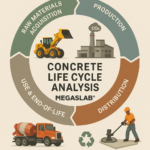In an era marked by environmental consciousness, the industrial sector is increasingly gravitating towards sustainable construction practices. A key component of this transition is the adoption of low carbon concrete flooring solutions. These innovative materials cater to the robust demands of industrial environments while aligning with global initiatives to reduce carbon emissions. This comprehensive article explores the various facets of low carbon concrete technology, its benefits, challenges, and its growing significance in the industrial sector.
Low Carbon Concrete

What is Low Carbon Concrete?
Low carbon concrete is a more sustainable variant of traditional concrete, designed to significantly reduce greenhouse gas emissions. This eco-friendly option is achieved by altering the composition and manufacturing processes, reducing reliance on high-carbon Portland cement.
The Global Impact of Concrete and Cement Production
The concrete and cement industry contributes significantly to global CO2 emissions, accounting for approximately 7-8% of the total. This stark figure underlines the critical need for transitioning to low carbon concrete to mitigate environmental impacts.
The Environmental Impact of Traditional Concrete
Traditional concrete’s high carbon footprint is a result of the carbon-intensive processes involved in producing construction materials, especially cement. Cement is a major emitter of carbon dioxide (CO2), with emissions stemming from both the raw materials it’s made of and the fuel burned to produce it (Low-Carbon Concrete: A Vital Challenge for Decarbonization – ECPA).
Technological Innovations and Advancements
Innovative Technologies in Production
Innovations in low-carbon concrete span the entire concrete and cement value chain. These include the use of alternative materials like fly ash and slag, and employing carbon capture technologies to reduce the carbon footprint of concrete production (The 3Cs of Innovation in Low-Carbon Concrete – RMI).
Carbon capture and utilization (CCU) in concrete production represent groundbreaking techniques that significantly reduce the carbon footprint, capturing CO2 emissions and integrating them into the concrete.
The Role of Research and Development
Continuous research and development are essential for further advancements in low carbon concrete technology. This includes exploring more sustainable aggregate options and developing new concrete mixes and source materials (Eco-concrete case studies – Renew).
Benefits of Low Carbon Concrete in Industrial Applications
Enhanced Durability and Longevity
Low carbon concrete maintains, and in some cases exceeds, the strength and durability of traditional concrete, ensuring longevity even under harsh conditions. The dense, impermeable surface of these concretes increases impact and abrasion resistance, crucial for industrial settings (Reducing embodied carbon in concrete floor slabs – Twintec).
Environmental and Sustainability Advantages
By significantly reducing CO2 emissions, low carbon concrete plays a crucial role in meeting global sustainability goals, helping industries minimize their environmental impact. This reduction in emissions is often achieved by optimizing slab thickness and reinforcement, and by using specific materials and defined production processes (Reducing embodied carbon in concrete floor slabs – Twintec).
Economic Implications
The long-term durability and reduced maintenance requirements of low carbon concrete can lead to considerable cost savings, enhancing a company’s marketability and contributing to overall economic efficiency.

Implementation in Various Industries
Case Studies of Low Carbon Concrete Applications
Case studies, such as the use of geopolymer concrete in flood-resilient renovations and residential extensions in Australia, demonstrate the practical applications of low carbon concrete in reducing carbon emissions and improving strength and durability. These studies highlight the material’s capacity to withstand challenging environmental conditions and its suitability for various industrial applications (Eco-concrete case studies – Renew).
Overcoming Challenges in Adoption
Transitioning to low carbon concrete involves challenges such as material sourcing and higher initial costs. However, these can be effectively mitigated through informed decision-making, supportive government policies, and continuous research and development. Adopting these solutions requires a holistic approach, considering regional and plant-level applicability of various technologies (Low-Carbon Concrete: A Vital Challenge for Decarbonization – ECPA).
MEGASLAB’s Role in Low Carbon Concrete Flooring
Innovations by MEGASLAB
MEGASLAB® has been at the forefront of low carbon concrete technology, delivering industrial concrete flooring that is both stronger and
more durable, with up to 50% fewer carbon emissions compared to traditional concrete. This reduction is achieved through blending age-old processes with cutting-edge nanotechnologies and fiber blends, ensuring a low carbon footprint while maintaining high performance (MEGASLAB’s Engineered Industrial Concrete Flooring).
MEGASLAB’s Contribution to Various Industries
MEGASLAB has proven its solutions in some of the toughest industries, including heavy equipment, food and beverage, warehousing and distribution, manufacturing, intermodal and ports, and waste management. Their concrete technology is tailored to withstand the heavy machinery typical in these sectors, ensuring long-lasting and resilient flooring solutions.
Advantages of MEGASLAB Concrete
MEGASLAB concrete provides numerous benefits, including maintenance efficiency, a three-year warranty on all applications, and fast installation without additional concrete treatments or finishes. This innovative approach saves time and resources, offering an efficient and sustainable flooring solution for various industrial applications.
The shift towards low carbon concrete flooring in industrial applications represents a significant step towards global sustainability efforts. Its benefits extend beyond environmental considerations, encompassing economic and performance advantages. As industries embrace these innovative solutions, they play a vital role in shaping a more sustainable and environmentally responsible future.
Learn more about MEGASLAB’s initiatives in low carbon concrete flooring.




